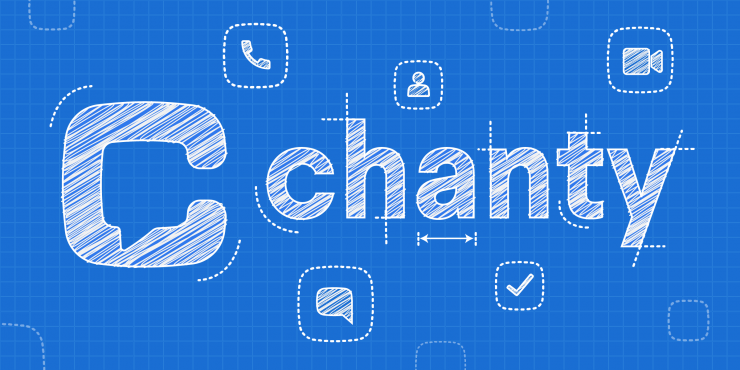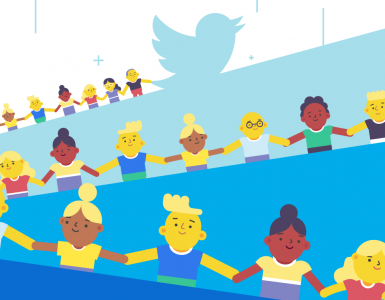Introduction
This is a story of competing with one of the biggest names in the industry of communication tools. This is a story of how we launched Chanty, an easy-to-use team collaboration tool. And finally, this is a story of numerous startup challenges we’ve solved.
I believe this story deserves your attention. Imagine a bootstrapped startup of a few fellows that is going against a SaaS giant. Add to this picture the fact that literally hundreds of apps are born in this industry each year. What’s more, it’s a personal story of how to trust yourself and let your ideas bloom.
I hope you get interested. Let’s dive right in.
How the idea of creating Chanty came
‘This shouldn’t be so complicated and clunky!’
I’ve used lots of other messaging apps. And I couldn’t get rid of the thought, ‘This shouldn’t be…’ each time I opened any workplace chat. Too complicated. Lacked audio and video calls. Too many limits. No team collaboration features. No built-in project management functionality. Endless pushes to upgrade immediately.
Even Slack, the most popular and feature-rich team chat, didn’t satisfy my needs. Yes, Slack did enormous good for businesses. This tool simplified team communication, squeezed out email threads, and fostered remote work. But with all due respect to Slack, it is not a fit for every team.
It’s too expensive. Its freemium pricing model has some major flaws, such as limited message search. With an ocean of features, Slack became too complex. Its notifications overwhelm users.
As you can see, the idea of creating an alternative was quite natural. I began thinking of a messaging platform in 2012 when I founded a software development company called Digifico. It was clear that my team needed a simpler, more humanized, and more flexible communication app with built-in collaboration functionality.
Long story short, I founded a team chat for the internal use of my team in 2017 and called it ‘Chanty’. Why Chanty? I wanted one solid word with a decent background. I ran a few Facebook ads with different company names and analyzed the audience’s reaction. Chanty was the winner! The primary meaning of this word is a song that sailors used to sing while working together. That was exactly what we needed. Later we found chat Chanty is a balance between 3 bodies inside each other and we are strong believers in a work-life balance environment and inner peace.
How Chanty started
Besides all difficulties, Chanty had a few strengths from the outset. First, the idea of a team communication software was already validated: we had a sea of competitors. All of them had already popularized the idea of a team chat app. Identifying a new market could have taken months. And lots of cash. Entering an established market, we had the ability to spend money on product development, not market research.
What’s more, the competition only proved that the demand for collaboration tools was high. The only thing we needed was to fit the market the right way. You can’t be, fortunately, or unfortunately, the best solution for everyone. You should be the best for your target audience.
Second, I decided to keep Chanty bootstrapped. So, Chanty wasn’t guided by someone else. I had three other profitable companies (focused on web design and development) when I launched Chanty. As a result, my team had that luxury—to put all their own ideas into action. Roughly speaking, Chanty was, at its outset, a fun side project.
Since we’ve started talking about the Chanty team here, let me tell you how it all started.
It’s obvious that building a product requires a few experienced professionals. From the very beginning, our team included an engineer, marketing manager, designer, and me.
When you already have a company name and team, it’s time to define the visual part of your brand. Being a graphic design expert, I took the logo development process seriously. I have hired three professional freelancers and got almost a hundred various ideas. It’s funny, but we’ve ended up with the very first version of the Chanty logo – the one I’ve created myself.
However, you don’t need to spend that much time and effort to come up with a logo. Yes, it’s a crucial part of branding. But logotype is not a deal-breaker. There’s always an option to create a company logo using online tools.
To release or not to release? It’s always a question. My second piece of advice is not to wait too long till you introduce the very first version of your app to the audience. Even if UX is far from perfect and you also wish the app worked faster. If you launch early, you know what to improve and which direction to move. Having a so-called minimum viable product (MVP) that solves at least one pain point that is important for your buyer persona, don’t hesitate to release your app.
Next thought on marketing promotion of a startup. When your product isn’t ready yet, the landing page is all you have. Don’t wait to make the first impression. Craft a website with crystal clear design and UX. Its goal is to generate leads who’ll be your early adopters (people willing to test your app out). So, the eye-catching call-to-action and signup form is a must-have.
The power of community for business growth
A community can be a powerful and cost-effective way to promote business by investing almost nothing. However, it’s easier said than done. Almost every company already has a Facebook page or website forum. However, it has turned out that having an additional communication channel doesn’t necessarily end up with user engagement and business growth. So, forget about dry as dust business pages. Instead, switch your focus to building a community to boost your business.
Why are communities so effective for business growth? Communities are a great marketing platform spiced up with brilliant product development opportunities. It’s not about spam and advertising. Communities are all about being helpful and relatable to your users as well as understanding their needs.
We’ve already created and successfully run a cozy private Facebook group here at Chanty:
Here’s the best part. How do we benefit from our Facebook Community? There’s no need to go far in search of examples. Our users help us shape our product map. We announce inside our group something like, ‘Hey! We are thinking of creating Feature 1 and Feature 2. Which one do you like most?’, gather feedback, and validate business ideas.
In addition to Facebook Insights and polls, Chanty’s Facebook fans’ discussions and comments tell us a lot about what our users want or struggle with. It’s a handy and easy-to-adopt method of supporting them and providing value. Here we always respond to users’ complaints, share updates in the first place, conduct exclusive contests, etc.
The Facebook community allows us to humanize our company with the help of nonbusiness interactions and friendly communication. Our brand is not just a product or company logo. Chanty is our faces, names, tone of voice. Here we have a brilliant opportunity to show Chanty’s human side and build relationships with users.
How feedback from early adopters helped us
We haven’t slept for weeks polishing our app. We all at Chanty tested every nook and cranny of it. It was ready for a real battle. And we needed some feedback and early adopters to consider their feedback, fix all bugs, tweak our roadmap, and proceed to a public beta. We needed people who were not developers or UX designers. We needed our first real users who didn’t know exactly where to go and what to click.
At first, we wanted to handpick ten teams to test Chanty. As you’ve already understood, the number of candidates on our list was…zero. And we had a very vague idea of where to find volunteers who are similar to our target audience. It was a challenge. And this challenge was accepted.
There are a few ways we’ve tested out to find early adopters:
*Since our startup is working without any side investors, our budget is quite limited. We considered many free resources as a way to maximize the number of our beta testers.
- Invite the people who left their emails on your landing page. But be prepared: a part of your list will unsubscribe and never test your app. This fact shouldn’t disappoint you: you’ll also find that some subscribers are eager to test your app ASAP.
- Involve your personal connections and circle of trust: friends, former colleagues, family… But resist the urge to invite your pets – they require too many tasty treats.
- Use beta testing platforms. As you can imagine, we have tried numerous beta test platforms like BetaList, Beta Family, Betabound, EarliBird, GetWorm. The only advice I can give – save your time by submitting to Betalist. To give you some numbers – BetaList brought us about 60 early adopters. Other beta testing platforms bring very little results.
- Be creative, invent your own methods. For instance, we adopted LinkedIn and combined market analysis with our goal to beta testers. Everyone and their moms know that understanding your target audience better is crucial for every business. So, we’ve put together a Google Form survey with a few questions and started contacting people on LinkedIn with a request to fill out our form and help us with our market research. If they filled out the form, we offered them to become a beta tester.
To give you a better idea of the numbers, contacting 125 people on LinkedIn resulted in 1 beta tester. This conversion rate is far from brilliant. However, the feedback we’ve received was literally priceless.
- Try to make it viral by motivating those who already signed up to share your startup with their friends. As a motivation, offer rewards your audience would be interested in.
- Adopt content marketing. Putting together reviews and comparisons of our competitors worked particularly well. Just define your biggest competitor, check if people are looking for its alternatives (Google Keyword Planner), write an in-depth article on the alternatives, put your product on the list, fuel the article with a few backlinks so it gets to the Google Top.
In our blog, we also reflected the stages of our startup journey sharing our first-hand experience in planning, design, and marketing. We hoped that would prevent other startup founders from repeating the mistakes we made on our way. The best part was that our readers were our target audience that we tried to convert to beta testers.
- Post on websites with a high level of engagement like Reddit and Quora. If your product is B2C this tactic should work particularly well.
That’s how we’ve found our early adopters. Needless to say that their feedback was brilliant and shaped our product development, from a proper pricing strategy and the value behind Chanty to the priority of new features and understanding the pain points of the target audience better.
Long story short, early adopters shaped the future of Chanty.
Where is Chanty going now?
My ultimate goal was to make Chanty the best communication and collaboration tool for the needs of small and medium teams. My big dream was to help businesses become more productive. In five years, Chanty has grown from a small fun project into an app used by more than 70,000 teams worldwide. But it feels like we started yesterday.
Getting so many people to choose Chanty in a highly competitive market already feels like a victory. I have never been so close to turning my idea into reality as I am now. ‘Did my dream come true?’, I’m asking myself.
What’s amazing and inspiring about a startup is that you challenge yourself every day, every minute. We face the next challenges: growing our team, making our product even better, etc.
But my ultimate goal now is to continue working with passion and dreaming big.
To wake up and go to bed with Chanty in mind.
To believe in myself, my idea, and my people.
To be happy because of that.
And this dream definitely came true.









Add comment